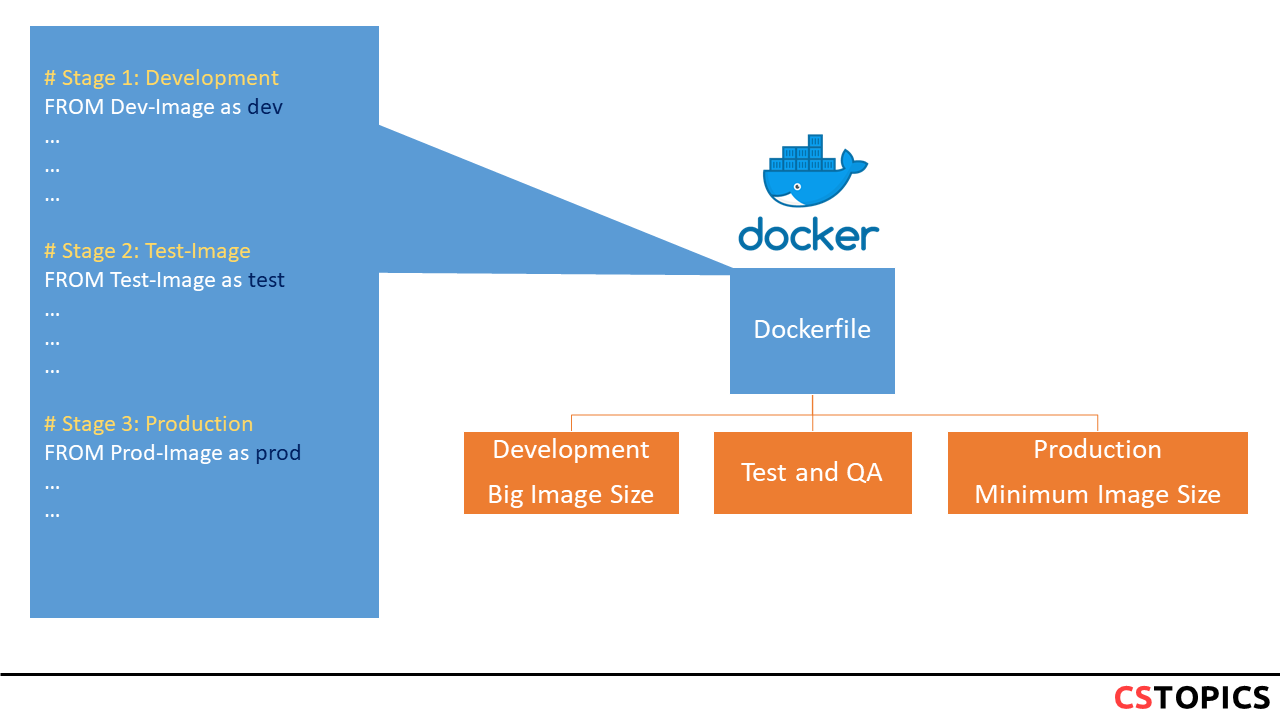Multi-Stage Builds
Multi-stage builds are a new feature requiring Docker 17.05 or higher on the daemon and client. Multistage builds are useful to anyone who has struggled to optimize Dockerfiles while keeping them easy to read and maintain.
One of the most challenging things about building images is keeping the image size down. Each instruction in the Dockerfile adds a layer to the image, and you need to remember to clean up any artifacts you don’t need before moving on to the next layer. To write a really efficient Dockerfile, you have traditionally needed to employ shell tricks and other logic to keep the layers as small as possible and to ensure that each layer has the artifacts it needs from the previous layer and nothing else.
It was actually very common to have one Dockerfile to use for development (which contained everything needed to build your application), and a slimmed-down one to use for production, which only contained your application and exactly what was needed to run it. This has been referred to as the “builder pattern”. Maintaining two Dockerfiles is not ideal.
Here’s an example of a Dockerfile.build and Dockerfile which adhere to the builder pattern above:
Dockerfile.build:
FROM golang:1.7.3
WORKDIR /go/src/github.com/alexellis/href-counter/
COPY app.go .
RUN go get -d -v golang.org/x/net/html \
&& CGO_ENABLED=0 GOOS=linux go build -a -installsuffix cgo -o app .
Dockerfile:
With multi-stage builds, you use multiple FROM statements in your Dockerfile. Each FROM instruction can use a different base, and each of them begins a new stage of the build. You can selectively copy artifacts from one stage to another, leaving behind everything you don’t want in the final image. To show how this works, let’s adapt the Dockerfile from the previous section to use multi-stage builds.
FROM golang:1.7.3
WORKDIR /go/src/github.com/alexellis/href-counter/
RUN go get -d -v golang.org/x/net/html
COPY app.go .
RUN CGO_ENABLED=0 GOOS=linux go build -a -installsuffix cgo -o app .
FROM alpine:latest
RUN apk --no-cache add ca-certificates
WORKDIR /root/
COPY --from=0 /go/src/github.com/alexellis/href-counter/app .
CMD ["./app"]

Name your build stages
By default, the stages are not named, and you refer to them by their integer number, starting with 0 for the first FROM instruction. However, you can name your stages, by adding an AS <NAME> to the FROM instruction. This example improves the previous one by naming the stages and using the name in the COPY instruction. This means that even if the instructions in your Dockerfile are re-ordered later, the COPY doesn’t break.
FROM golang:1.7.3 AS builder
WORKDIR /go/src/github.com/alexellis/href-counter/
RUN go get -d -v golang.org/x/net/html
COPY app.go .
RUN CGO_ENABLED=0 GOOS=linux go build -a -installsuffix cgo -o app .
FROM alpine:latest
RUN apk --no-cache add ca-certificates
WORKDIR /root/
COPY --from=builder /go/src/github.com/alexellis/href-counter/app .
CMD ["./app"]
Stop at a specific build stage
When you build your image, you don’t necessarily need to build the entire Dockerfile including every stage. You can specify a target build stage. The following command assumes you are using the previous Dockerfile but stops at the stage named builder:
A few scenarios where this might be very powerful are:
- Debugging a specific build stage
- Using a debug stage with all debugging symbols or tools enabled, and a lean production stage
- Using a testing stage in which your app gets populated with test data, but building for production using a different stage which uses real data
Use an external image as a “stage”
When using multi-stage builds, you are not limited to copying from stages you created earlier in your Dockerfile. You can use the COPY --from instruction to copy from a separate image, either using the local image name, a tag available locally or on a Docker registry, or a tag ID. The Docker client pulls the image if necessary and copies the artifact from there. The syntax is:
Use a previous stage as a new stage
You can pick up where a previous stage left off by referring to it when using the FROM directive. For example:
FROM alpine:latest as builder
RUN apk --no-cache add build-base
FROM builder as build1
COPY source1.cpp source.cpp
RUN g++ -o /binary source.cpp
FROM builder as build2
COPY source2.cpp source.cpp
RUN g++ -o /binary source.cpp
Exercise
create a Dockerfile with multi-staging feature as follows:
* take nginx as the base for production
* the html root directory inside container: /usr/share/nginx/html/
* take production as the base for test
* in the production we have only index.html which is served by nginx
* in the test we have index.html and index-test.html which are served by nginx
* build two images by --target <..> options using different tags
* run the containers on the different ports
* test your running containers:
* check the production container: it is not serving index-test.html
* check the test container: it is serving index-test.html